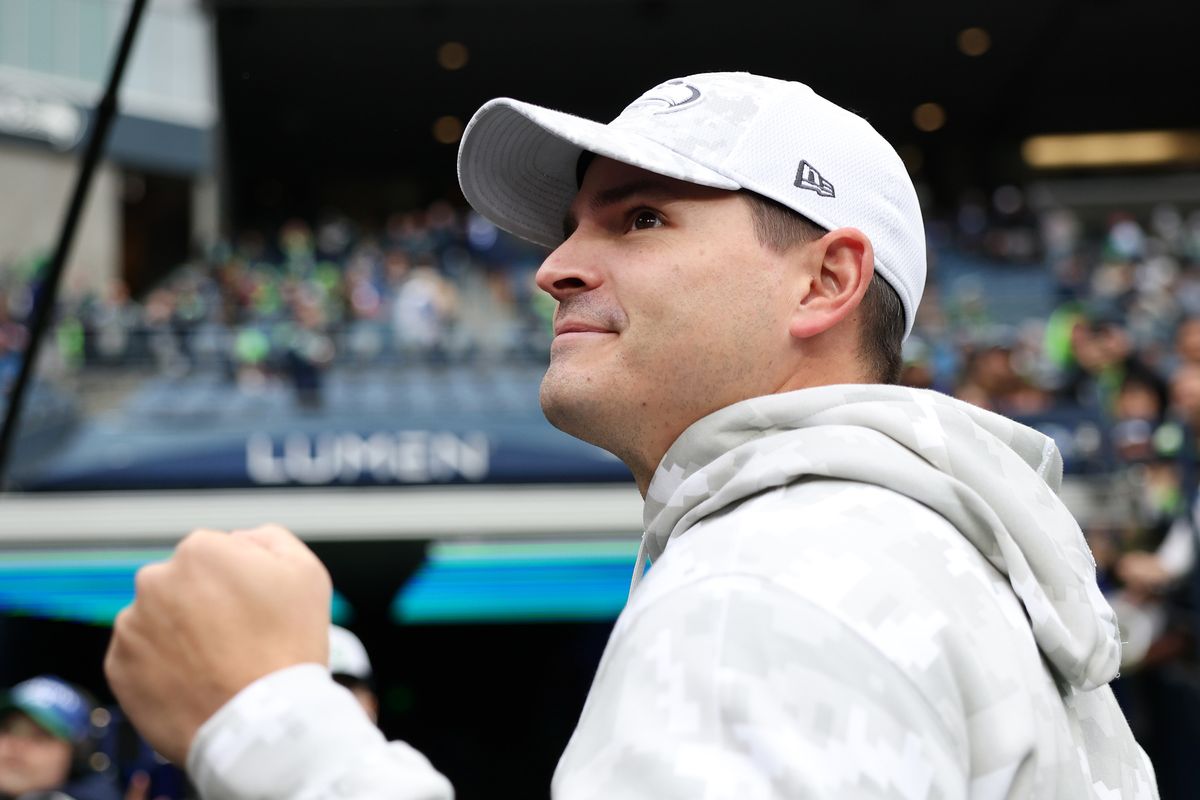Commentary: Seahawks made strides this season. How many more are needed to contend?

CHICAGO – As a dense fog encircled Soldier Field last Thursday, three words flashed above the disjointed stadium’s entrance, via dual video boards:
GROWTH REQUIRES CHANGE
That message was equal parts ironic and appropriate.
Ironic because Soldier Field, which has housed the Chicago Bears since 1971, owns a comically complicated relationship with change. The century-old stadium was renovated in 2002, when its interior was ripped out and replaced with tons of towering steel. That material marries awkwardly with the existing exterior, a facade of limestone and neoclassical columns. The result is an architectural fever dream, two eras fused together like Frankenstein’s monster and dumped on Lake Shore Drive.
Appropriate because the Bears, amid a 10-game losing streak, fired head coach Matt Eberflus and offensive coordinator Shane Waldron this fall, and have made just two playoff appearances since 2010.
But those three words apply to another team, too.
The Seahawks – who crawled away with an unconvincing 6-3 win in that same stadium – embraced change last offseason, parting with coach Pete Carroll after 14 (mostly) successful seasons. Carroll’s tenure included 11 winning records, 10 playoff appearances, a Super Bowl championship and back-to-back 9-8 finishes in 2022 and 2023.
In justifying the decision last January, general manager John Schneider pushed back on the assessment that the Seahawks had become stagnant. He instead said: “It’s more of like a growth. How are we getting better every day?”
(But is removing Carroll, and keeping Schneider, akin to replacing half a stadium, inelegantly fusing together two eras? Discuss among yourselves.)
In some ways, change has arrived. In others, it has not.
Behind first-year coach Mike Macdonald and a supporting cast of new coordinators, the Seahawks have arrived at a familiarly lukewarm place, facing the possibility of a third consecutive 9-8 finish. They were mathematically eliminated from playoff contention last weekend, draining the significance from Sunday’s regular-season finale against the (NFC West champion) Los Angeles Rams.
Granted, the Seahawks have grown in specific places throughout Macdonald’s debut. They rank 10th in the NFL in scoring defense (21.4 points allowed per game), after sitting 25th in that category (23.6 points allowed) in Carroll’s finale. They’re also tied for sixth in opponent yards per pass attempt (6.8) and 10th in sacks (42), reflecting a defense with a talented secondary and capable pass rush. The Seahawks also sit sixth in passing yards (3,810), behind five playoff hopefuls (Cincinnati, Tampa Bay, Detroit, Minnesota and Baltimore).
But considering Carroll’s 10 playoff trips in 14 tries, Macdonald’s debut season cannot be considered a success.
Remember, the former Ravens defensive coordinator emphasized when he was introduced that there was no rebuild required.
“There’s a lot of great players on this team,” Macdonald said on Feb. 1. “We’ve done a great job of drafting. It’s a young core. So we’ve got a great opportunity to build these guys and build a really competitive team sooner than later.”
Which begs the question:
To accelerate that growth – to transform from fringe playoff team to Super Bowl contender – how much more change is required?
That’s the central question Macdonald must answer this offseason, and it starts at quarterback. Is Geno Smith – whose contract runs through 2025 – the Seahawks’ best option under center, in the upcoming season and beyond? The 34-year-old is on pace to produce the highest completion percentage (70.2%) of his three-season stint as starter, and he needs 185 passing yards Sunday to reach a personal high-water mark as well. But his 15 interceptions also sit tied for second in the NFL and have repeatedly punctured otherwise promising drives.
Still, it’s one thing to acknowledge Smith’s obvious weaknesses. It’s another to identify an available quarterback who could more consistently succeed in Seattle.
And, when it comes to change, can more be done to accommodate the quarterback? Smith has taken the third-most sacks in the NFL (48) as an offensive line in need of obvious upgrades failed to find a rhythm. The Seahawks rank 30th in rushing yards per game (93.8) as well.
Though, it’s hard to efficiently run the ball … without running the ball.
So, will Macdonald and Co. grant offensive coordinator Ryan Grubb a second season? While there have been some encouraging signs – e.g. wide receiver Jaxon Smith-Njigba’s second-year surge – the Seahawks offense has been stymied by inconsistency. Wide receiver DK Metcalf and running back Kenneth Walker III have slogged through disappointing statistical seasons, while the Seahawks sit tied for 30th in total rush attempts (359).
Schneider, too, is not blameless for the Seahawks’ second consecutive postseason snub. His offseason additions – linebackers Tyrel Dodson and Jerome Baker, center Connor Williams, safeties Rayshawn Jenkins and K’Von Wallace, right tackle George Fant, tight end Pharoah Brown, linebacker Trevis Gipson, etc. – have made an almost imperceptible impact.
“Sometimes you have to make really tough decisions,” Macdonald said after the Seahawks waived Dodson and traded Baker, passing the reins to an improved linebacker duo of Ernest Jones IV and Tyrice Knight. “That’s part of my responsibility. That’s part of John [Schneider’s] responsibility in doing what’s best for the club at all times. We owe that to the fans and to our football team and the rest of the locker room.”
There are more really tough decisions on deck.
For the Seahawks to excel, how much change is necessary?
We’ll all see soon enough.